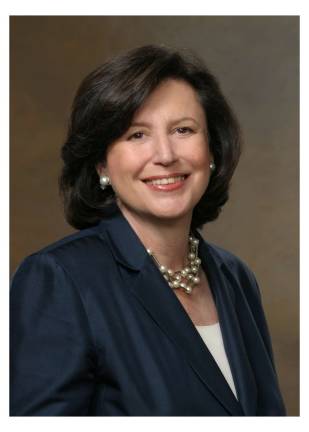Spreading a Love of Science Ellen V. Futter

The office of American Museum of Natural History president Ellen V. Futter overlooks 77th Street and the presently-bare trees in surrounding Theodore Roosevelt Park. Located in a turret on the second floor of the museum, the circular office and its series of draped windows offers an especially beautiful view during snow fall, she said, a scene that hasn’t been lacking in recent weeks.
Even as a child growing up on Long Island, where she spent days outdoors, catching butterflies and collecting rocks and sea shells, Futter had a “deep affinity” for the natural world, and a regard for the institution she now heads. When she and her siblings visited their grandmother, who lived on the Upper West Side, trips to the museum were a frequent pastime.
“I remember coming here with my brother’s birthday party to the Hayden Planetarium,” she said from her office on a cold but snowless January day. “And thinking that was the coolest thing I’d ever seen.”
Prior to her time at the famed museum on Central Park West, Futter served as president of Barnard College, her alma mater, a post she held for 13 years. Barnard, like other women’s colleges, has long advanced women in science degrees and careers, said Futter, who also has a law degree from Columbia University. Advancing science education for future generations remains a fundamental component of her professional mission.
“The need for enhancing science literacy for the general public, for enhancing and empowering teachers to teach science and making science both more accessible to and more appealing to young people so that they do pursue study and potentially careers in it, is enormous,” she said. “At the museum and other institutions of our type, we think we have an enormous opportunity to complement and support and fuel what schools do.”
During Futter’s two decades as museum president, the institution has expanded its public offerings, with new and renovated exhibits, such as the Hall of Biodiversity, and new buildings, like the Rose Center for Earth and Space (with the new Hayden Planetarium), as well as its education initiatives. Along with other institutions in the city, the museum introduced the science education program Urban Advantage in 2003, which now serves a third of the city’s middle schools. In 2008 the institution began offering a PhD program in comparative biology, and now has a Master’s program in earth science education.
The integration of scientific study and education will continue with the construction of the 218,000-square-foot Gilder Center for Science, Education and Innovation, a $325 million project the museum announced in December and hopes to open by 2020, in commemoration of the their 150th anniversary.
“This is a place where you instantly see things that per force awaken wonder,” Futter said. “As powerful as the new digital technologies that we use every day are, the fact is there’s nothing more powerful than the power of reality.”
Playing a role in a Hollywood film franchise doesn’t hurt, either. After the 2006 release of the Ben Stiller film Night at the Museum, in which a night guard discovers that the museum’s exhibits come to life after dark, the institution started hosting children’s sleepovers and self-guided tours of the film’s highlights. Last year, the museum held its first adult sleepover.
Futter, who still collects sea shells, said the film, like the museum itself, instills a sense of curiosity, which offers a gateway for public science education.
“Things like the Night at the Museum movie create an acute public interest in a place, in what’s in it and what we do,” she said. “You take acute public interest, and you create a teaching moment.”